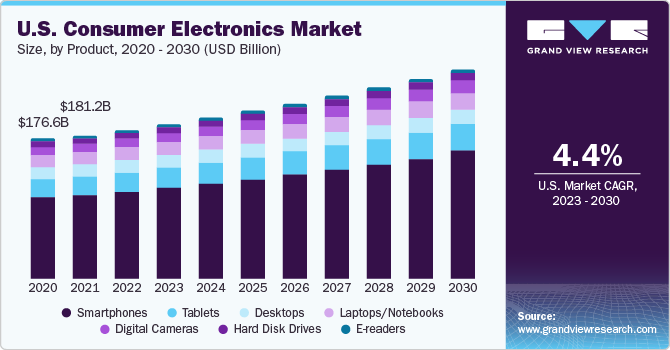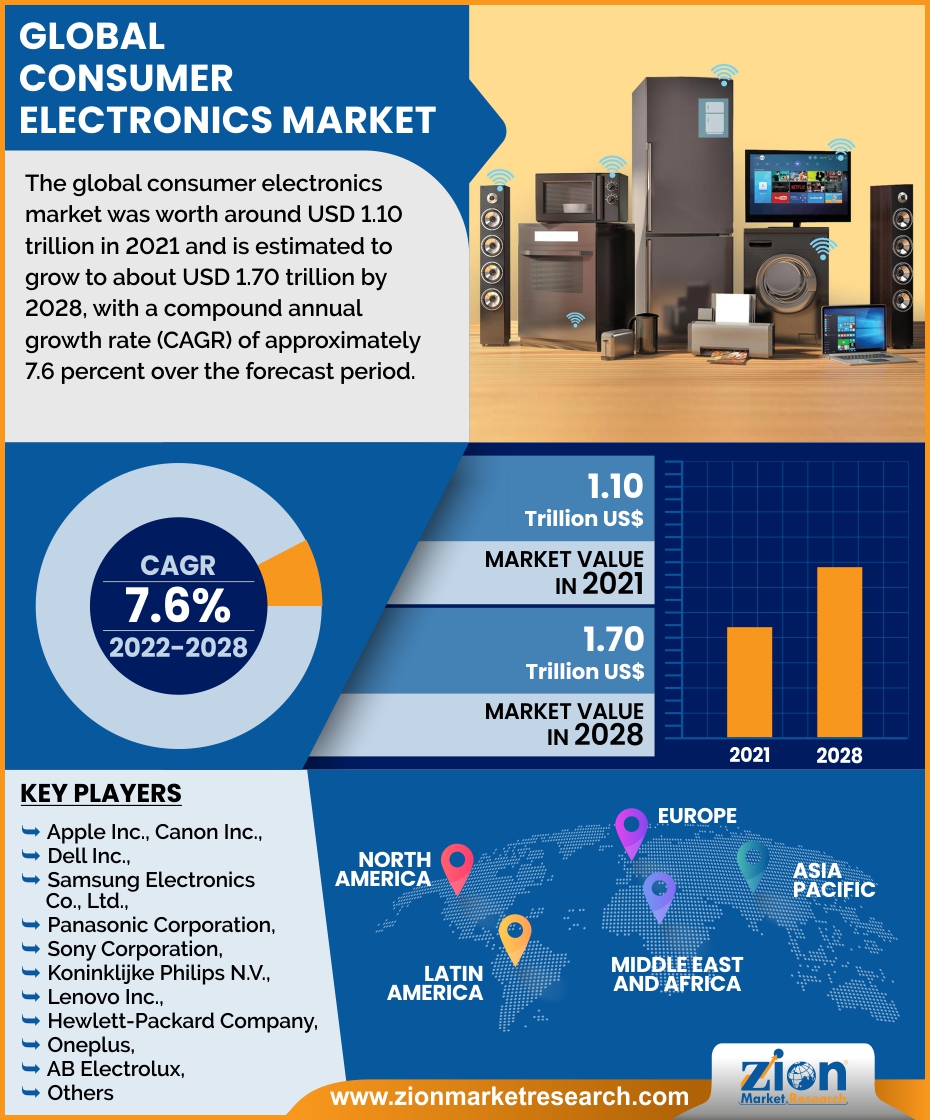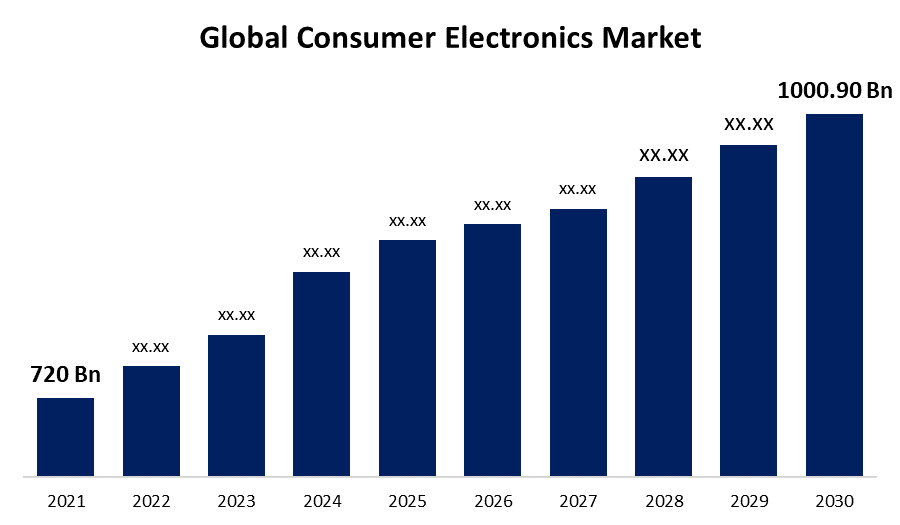Overview of Consumer Electronics: Trends, Insights, and Market Growth

The consumer electronics industry is one of the fastest-growing sectors globally, with continuous innovation shaping how we live, work, and interact. From smartphones to smart home devices, the evolution of consumer electronics reflects an ever-changing technological landscape that is redefining the way people experience the world.
This article explores the key aspects of the consumer electronics market, including its growth drivers, emerging trends, challenges, and future outlook. We will also look at some of the most influential players in the market and the technologies that are revolutionizing the industry.
What Are Consumer Electronics?
Consumer electronics refer to electronic devices designed for personal use, typically for entertainment, communication, and productivity. These products have become an integral part of daily life, transforming everything from how we communicate to how we manage our homes and health.
Some examples of consumer electronics include:
- Smartphones
- Laptops and Tablets
- Smart TVs
- Wearable Devices (e.g., smartwatches, fitness trackers)
- Smart Home Devices (e.g., smart thermostats, smart speakers)
- Gaming Consoles
- Headphones and Earbuds

Key Trends in the Consumer Electronics Market
The consumer electronics market is constantly evolving with innovations that push the boundaries of what’s possible. Here are some key trends that are shaping the industry:
1. Smart Home Technology
The demand for smart home devices has surged in recent years, driven by the need for convenience, energy efficiency, and enhanced security. Products like smart thermostats, lights, security cameras, and voice assistants are becoming standard in many homes.
Example:
– Amazon Echo and Google Nest are leading players in the smart speaker and smart home technology space.
– Smart thermostats, such as the Nest Learning Thermostat, allow homeowners to control their home’s temperature remotely, saving energy and reducing costs.
2. Wearables and Health Tech
Wearable devices are gaining popularity, with innovations in fitness tracking, health monitoring, and seamless integration with other devices. Smartwatches, such as the Apple Watch, and fitness trackers like Fitbit offer real-time insights into users’ health and activity levels.
3. 5G Connectivity
The introduction of 5G technology is revolutionizing the consumer electronics market. 5G promises faster internet speeds, lower latency, and the ability to connect more devices simultaneously. This advancement opens up opportunities for new products, such as enhanced smartphones, AR/VR headsets, and connected cars.
4. Augmented Reality (AR) and Virtual Reality (VR)
AR and VR are becoming more accessible and are changing how we interact with technology. From gaming to education, these immersive technologies are finding applications in a variety of industries.
Example:
– Oculus VR is a leader in virtual reality gaming and experiences.
– Pokémon Go, an augmented reality game, exemplifies how AR can blend the physical and virtual worlds.
Market Growth and Opportunities
The global consumer electronics market is expanding rapidly, fueled by technological innovations and increasing consumer demand. According to recent reports, the market is expected to grow at a compound annual growth rate (CAGR) of around 8% from 2023 to 2030.

1. North America and Europe
These regions continue to lead the consumer electronics market, driven by high disposable incomes, advanced technological infrastructure, and strong consumer demand for the latest gadgets. In the U.S., the consumer electronics market is expected to reach a substantial valuation, fueled by widespread smartphone adoption, smart home device integration, and growing interest in fitness technology.
2. Asia-Pacific (APAC)
The APAC region is witnessing the fastest growth in consumer electronics, particularly in emerging markets such as India and China. The increasing adoption of smartphones, wearable devices, and smart home products is contributing to this growth. China, in particular, is home to some of the largest manufacturers of consumer electronics, including Huawei, Xiaomi, and Lenovo.
3. Latin America and Africa
While still smaller markets, Latin America and Africa are expected to experience steady growth in the adoption of consumer electronics as middle-class populations increase, bringing greater purchasing power and interest in advanced technology.
Challenges in the Consumer Electronics Industry
Despite its rapid growth, the consumer electronics industry faces several challenges:
1. Supply Chain Disruptions
Global supply chain disruptions, particularly in semiconductor production, have impacted the availability of key consumer electronics like smartphones and laptops. Companies have struggled to meet demand due to a shortage of components, leading to delays and price increases.
2. Environmental Impact
The environmental footprint of manufacturing, using, and disposing of electronics is a growing concern. E-waste is a major issue, with millions of tons of electronic products being discarded each year. The industry is increasingly focusing on developing sustainable practices, such as using recyclable materials and minimizing energy consumption in manufacturing.
3. Increasing Competition
The consumer electronics market is highly competitive, with numerous players vying for market share. Companies need to continuously innovate and provide value-added features to stay ahead of the competition. For instance, smartphone brands like Apple, Samsung, and Google are constantly launching new devices with advanced features to cater to ever-evolving consumer preferences.
The Future of Consumer Electronics
The future of consumer electronics looks incredibly promising, driven by advancements in artificial intelligence (AI), machine learning, internet of things (IoT), and sustainable innovations. As new technologies emerge, we can expect even more seamless integration of devices, smarter interactions, and improved user experiences.
1. The Rise of AI and Automation
AI will continue to play a crucial role in personalizing consumer experiences. From voice assistants to automated home systems, AI is making products smarter and more intuitive. Imagine a home that adjusts lighting, temperature, and security based on your preferences—AI will make it all possible.
2. Advancements in Consumer Health Devices
Wearable devices will go beyond fitness tracking to monitor critical health metrics, such as heart rate variability, blood oxygen levels, and even mental health. This could lead to more personalized health interventions and preventative care.
3. Sustainable Electronics
Sustainability will become a key focus in the consumer electronics sector. As consumers and regulators demand more eco-friendly products, manufacturers will prioritize sustainability by using recyclable materials, reducing energy consumption, and creating longer-lasting devices.
Further Reading:
– How AI is Transforming Consumer Electronics
– Sustainability in Electronics Manufacturing
FAQs on Consumer Electronics
Q1: What is the largest segment in the consumer electronics market?
A: Smartphones dominate the largest segment in the consumer electronics market, followed by smart home devices and wearable tech.
Q2: How do consumer electronics impact the environment?
A: Consumer electronics contribute to e-waste and energy consumption. However, advancements in recycling and energy-efficient technologies are helping mitigate these impacts.
Q3: What are the leading companies in the consumer electronics market?
A: Leading companies include Apple, Samsung, Sony, LG, and Huawei, among others.
Q4: How can businesses stay competitive in the consumer electronics industry?
A: Innovation, customer-centricity, and embracing sustainable practices are essential for staying competitive in the market.
Conclusion
The consumer electronics industry is undergoing a remarkable transformation, driven by technological advancements and evolving consumer demands. From smart homes to wearable health tech, the possibilities are limitless. As the market continues to expand, companies must focus on innovation, sustainability, and creating value for consumers to thrive in this highly competitive sector.
The future of consumer electronics is bright, and staying ahead of the curve will ensure that businesses remain relevant and successful in this fast-paced industry.

